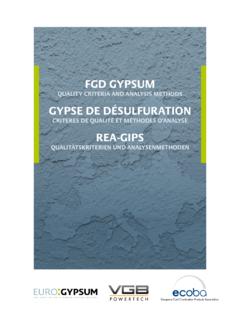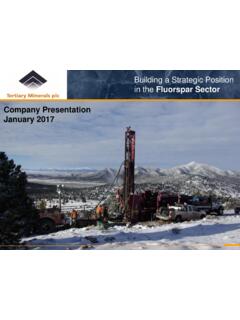Transcription of Factsheet on: What is Gypsum?
1 ENVIRONMENT AND RAW MATERIAL COMMITTEE Factsheet on: what is gypsum ? DATE: 16-07-2007 I. Natural gypsum A. Introduction The mineral gypsum precipitated some 100 to 200 million years ago when sea water evaporated. From a chemical point of view it is Calcium Sulphate Dihydrate ( ) deposited in sedimentary layers on the sea bed. Under high pressure and temperature gypsum turns into Anhydrite (CaSO4). In nature, gypsum and Anyhdrite occur as beds or nodular masses up to a few metres thick. gypsum is formed by the hydration of Anhydrite. The depth of hydration can range from the surface of the deposit down to three hundred metres, depending on temperature and pressure, topography and the structure of the deposit.
2 Anhydrite is often mined in conjunction with gypsum , but is comparatively limited in its technical applications. The content of gypsum in sedimentary rock varies from 75% to 95%, the rest being clay and chalk. B. Extracting Natural gypsum gypsum /Anhydrite are produced from open-cast mines, or underground mines using pillar and stall mining methods, that give extraction rates of up to 75%. gypsum is normally only screened to remove fines (mainly mudstones), then crushed and finely ground. gypsum /Anhydrite for cement manufacture is supplied in crushed form for further fine grinding with cement clinker. C. Processing Natural gypsum When gypsum (CaSO4,2H2O) is ground to a powder and heated at 150 to 165 C, three-quarters of its combined water is removed producing hemi-hydrate plaster (CaSO4,1/2H2O), commonly known as the Plaster of Paris.
3 When this powder is mixed with water the resulting paste sets hard as the water recombines to produce gypsum again. This process can be repeated almost indefinitely, with important implications for recycling. 2 II. Synthetic gypsum A. Introduction The gypsum Industry is working towards building value for society by offering safe, economic and recyclable products for the home owner using substitutes to natural gypsum whenever possible, in order to reduce the pressure on natural resources. B. FGD gypsum An intelligent alternative is gypsum that comes from the flue gas desulphurisation plant (FGD) of the power station industry. This FGD gypsum is the end product of a wet purification procedure with natural lime, that essentially forms according to the same laws as natural gypsum but in a speeded-up process taking only a few hours.
4 FGD gypsum is an important supplement to the supply of natural gypsum . This synthetic gypsum has a higher purity ( gypsum content of 96%) than most natural gypsum (80%). This means that lower quality gypsum can be blended with high purity Desulphogypsum, allowing material that would not have been mined in the past to be classified as exploitable reserves. Processing FGD gypsum Of the flue gas desulphurisation processes available, limestone-based scrubbing processes have proved the most popular. The desulphurisation process takes place in scrubbing towers in which the flue gases are brought into contact with an aqueous suspension containing powdered limestone or slaked quicklime as its alkaline component.
5 The SO2 is washed out by the water, oxidised to Sulphates SO3 in the aqueous solution, and precipitated with Calcium from the limestone/quicklime into Dihydrous Calcium Sulphate (CaSO4,2H2O), gypsum . The gypsum crystals are separated out of the suspension as a moist, fine crystalline powder with the aid of centrifuges or filters. C. Phosphogypsum,Titanogypsum and Citrogypsum 1. Phosphogypsum Phosphoric Acid is a commodity chemical of which large quantities are used in the production of fertilisers and detergents. It is obtained by processes based on the decomposition of Phosphate minerals with Sulphuric Acid. Tricalcium Phosphate reacts with Sulphuric Acid to form Phosphoric Acid and Calcium Sulphate.
6 Most usually, the less soluble Calcium Sulphate is separated from the Phosphoric Acid by filtration. The Calcium Sulphate appears generally as Hemihydrate or Dihydrate, depending on process temperature conditions and the Sulphuric and Phosphoric Acid concentrations. The limiting factors for a more extensive use by the gypsum industry are rest impurities, deviant crystal shape of the gypsum and quality fluctuations, which can lead to a behaviour not compatible with gypsum processing, and the higher level of natural radioactivity, depending on the phosphoric rock, especially when compared to other gypsum sources, which creates a psychological barrier to its use. The psychological and subjective barriers to the public acceptance of this Phosphogypsum may be a much stronger brake to development than the technical factors.
7 3 2. Titanogypsum Titanium Dioxide is a white pigment and is, by far, the most important pigment in terms of quantity. World production of Titanium Dioxide is approximately 4 mio tonnes/year, of which about one-half is produced by the Sulphate process, the other half by the Chloride process. Only the Sulphate process outputs gypsum , of which a maximum of about 50%, is the so called White gypsum , which can be considered for use by the gypsum industry. 3. Citrogypsum Citric Acid is a component found in almost all plant and animal species, and is pivotal in the energy cycle of living organisms. Large quantities of Citric Acid for use in food, pharmaceutical and detergent industries are produced by mycological fermentation of crude sugar solutions such as molasses.
8 In order to free Citric Acid from impurities such as proteins and sugars, it is precipitated with lime to Calcium Citrate and washed. Pure Citric Acid is then recovered by acidification with Sulphuric Acid and filtering off from the formed gypsum . Technically, this gypsum can be purified to a grade which can be processed by the gypsum industry. Part of this gypsum , however, is used as a filter aid to remove complex trace metals. It has a blue colour due to absorption of Ferric Hexacyanoferrate complexes which can only be removed by high temperature calcination producing Anhydrite (usable by the cement industry). D. Fluoroanhydrite For the production of Hydrofluoric Acid the mineral Fluorspar or Fluorite is heated with Sulphuric Acid.
9 As the reaction is normally conducted in dry conditions at elevated temperatures, the resulting Calcium Sulphate is formed in the anhydrous form, Anhydrite. E. Other Synthetic gypsum Small amounts of gypsum are recovered by the production of some organic acids like Tartaric, Lactic, Formic and Oxalic Acid. For the production principle please refer to the Citric Acid paragraph (point II, ). Additionally, all processes which end with the sub-product Sulphuric Acid are potential gypsum producers. Neutralisation of acidic effluents with lime or limestone yields gypsum , for which the potential usage depends on the impurities remaining. Titanogypsum here is the classic example.
10 The removal of Sulphates from brines with the help of lime produces gypsum - the high Magnesium content of this salt gypsum is one of the main obstacles to its use. F. Conclusions Natural gypsum will continue to cover the basic raw material needs of the gypsum industry, followed by FGD gypsum . The most important potential of other synthetic Gypsums than FGD gypsum lies in the use of purified Phosphogypsum. Next to that is some potential in the use of purified Titanogypsum. In the past, both the Phosphoric Acid and the Titanium Dioxide industries have shown a systematic close down of production facilities in Europe. Investments in either the purification of the produced Gypsums, or in finding applications for the Gypsums produced, may be essential for the future viability of these sites.





